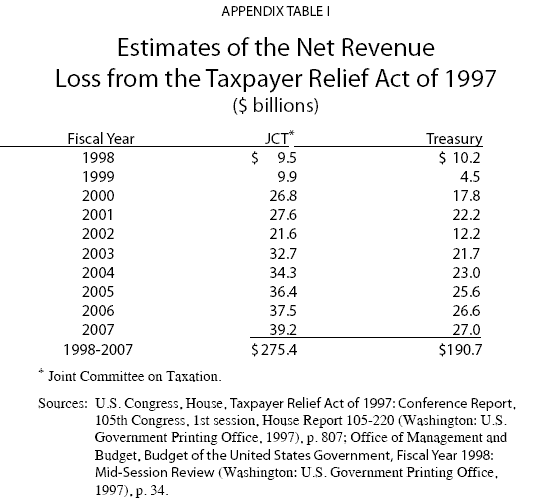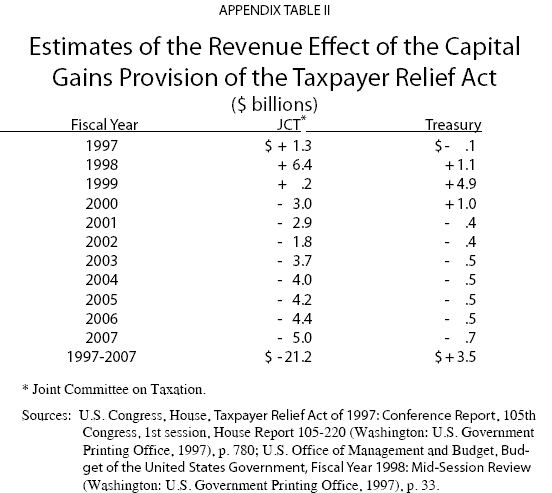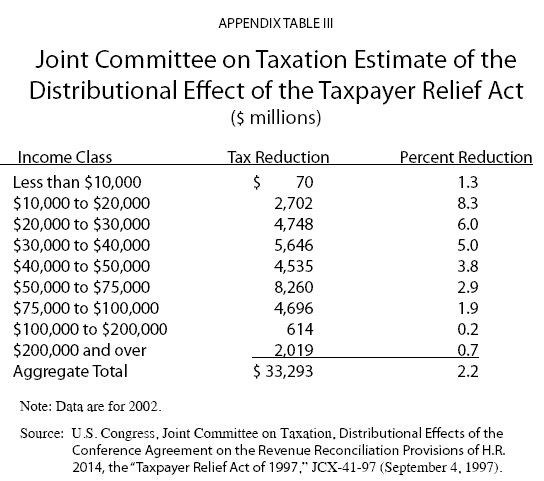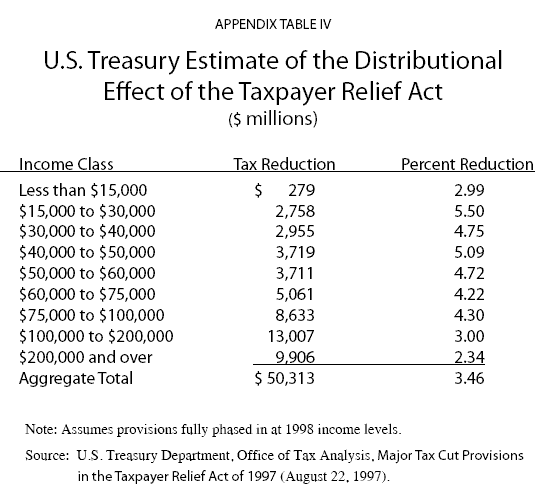Still smarting from their defeat in the 1995 budget battles with President Bill Clinton, congressional Republicans entered the 105th Congress in January 1997 determined to avoid another such confrontation. Having retained control of Congress in the 1996 elections, they hoped to make a deal with the president to both cut taxes and achieve their goal of a balanced federal budget in 2002. In May 1997, Republican congressional leaders signed off on a budget agreement negotiated with the Clinton administration. The agreement broadly outlined the features to be included in budget legislation, providing for a net tax cut of $85 billion between 1998 and 2002.1 Gross revenues would be cut by $135 billion, offset by $50 billion in revenue increases, most of it ($33 billion between 1997 and 2002) from an extension of the airline ticket tax.
"Republicans entered the 105th Congress determined to make a deal with the President."
A major factor allowing the agreement was the Congressional Budget Office (CBO) decision to sharply revise upward its estimate of the federal government's future income absent any budget deal. In a May 2, 1997, letter to the chairmen of the House and Senate Budget Committees, CBO Director June O'Neill estimated that revenues for 1997 would be $45 billion higher than the CBO had forecast in January. (The CBO never explained the exact source of the additional revenue.) Dr. O'Neill also said revenues would be higher by "similar amounts" in the years 1998 through 2002.2 Both Congress and the White House took this to mean that projected deficits would be lower by $225 billion between 1998 and 2002. This anticipated revenue "windfall," gained by multiplying $45 billion by five years, made the budget deal possible.3
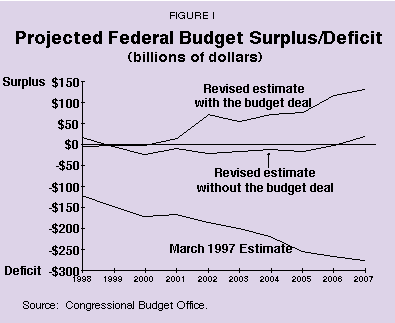
Significantly, the details of the tax legislation were not spelled out in the budget agreement. But Republicans received the cuts in capital gains and estate tax rates they wanted, along with a $500 per child tax credit. President Clinton came away with a commitment reserving $35 billion for education tax initiatives. Both sides agreed to extend the Airport and Highway Trust Fund excise taxes, due to expire on September 30, 1997. Beyond these specifics, the chairmen of the tax-writing committees, Bill Roth (R-Del.) of the Senate Finance Committee and Bill Archer (R-Texas) of the House Ways and Means Committee, reserved the right to draft their own bills.
The lack of clear understanding about key details led to considerable wrangling between the White House and congressional tax-writers throughout the summer of 1997. The Clinton administration and congressional Republicans had sharp differences of opinion and so did the Senate Finance Committee and the House Ways and Means Committee. Eventually, however, the details were worked out. The Taxpayer Relief Act of 1997 was approved by overwhelming majorities in both the House and Senate. President Clinton signed it into law on August 5.4
A CBO report after passage concluded that on balance the deal reduces the budget deficit. However, its impact is far more modest than its supporters would have us believe. The economy rather than the budget deal deserves most of the credit for reducing the deficit. As Figure I shows, revised economic assumptions and technical adjustments would have reduced the deficit in 2002 to just $63 billion if there had been no budget deal at all. Indeed, the budget deal actually increases the deficit by more than $20 billion in 1998.
[page]"The budget would have been in near balance by 2002 without any budget deal."
The centerpiece of the tax package is the $500 per child tax credit, reducing the income tax liability for taxpayers with dependent children. While the bill does not limit the number of children to whom the credit may apply, it does limit the total amount of credit a taxpayer can claim. Also, for single taxpayers with adjusted gross incomes (AGI) above $75,000 and married couples with incomes above $110,000, the credit is reduced by $50 for each $1,000 of AGI above the threshold. The credit is not refundable.
It is not entirely clear where the idea for the child credit originated, and there is no economic rationale for it. Conservative groups had complained for several years about the "anti-family bias" in the tax code. However, this concern mainly centered on the erosion of the real value of the personal exemption.5 Unlike a tax credit, the personal exemption – which may be taken for each dependent – reduces taxable income by the amount of the exemption, rather than directly reducing one's tax liability. The value of the dependent personal exemption has declined in real terms by more than one-third over the last 50 years.6
"The centerpiece of the tax package is the $500 per child tax credit."
In 1991 the National Commission on Children proposed a $1,000 refundable tax credit for all children.7 This was intended as a modified negative income tax that would replace other parts of the tax and welfare systems. Economists Eugene Steuerle and Jason Juffras, authors of the $1,000 credit proposal, explained its need as follows:8
- Households with children have borne more than their share of tax increases in the past decade.
- Children with equal needs do not receive equal treatment in the welfare system, violating a basic principle of fairness.
- The welfare and tax systems together create strong disincentives for low-income parents to work, marry or move to find a job.
Shortly thereafter, conservatives began turning away from personal exemption increases, adopting the tax credit approach instead.9 Subsequently, the tax credit became a top legislative priority for Christian and pro-family groups that are important to the Republican Party. These groups saw the child credit as a means of allowing working mothers and fathers to spend less time at work and more time with their children.10 Eventually, congressional Republicans officially adopted a $500 child credit as part of their "Contract With America."
When Republicans took control of Congress, enactment of the child credit became a high priority. On March 21, 1995, early in the 104th Congress, the House Ways and Means Committee reported a bill embodying provisions of the contract. The child credit provision would have allowed a $500 credit for taxpayers with incomes up to $200,000.
It is still not clear why the child credit, rather than an increase in the personal exemption, became official Republican tax policy. In previous years, Republicans had opposed tax credits on principle in favor of deductions and exemptions.
Tax exemptions and tax credits have very different effects; the value of the former depends on marginal tax rates, while the value of the latter does not. When one receives an exemption, taxable income is reduced by that amount. Thus the tax saving is a function of one's marginal tax rate – and the higher the marginal tax rate, the greater the value of the exemption. In the case of a tax credit, taxable income is unchanged but one's tax liability is reduced by the amount of the credit. Marginal tax rates do not affect its value.
Furthermore, for taxpayers at the income threshold for a higher tax bracket, an exemption or deduction might result in a lower marginal tax rate by reducing taxable income below the threshold, but a tax credit will not. The tax credit is phased out for higher-income taxpayers, in a way that increases marginal tax rates for single taxpayers with AGIs above $75,000 and joint-filers earning more than $110,000.
The child credit was sold primarily as an issue of social policy. Its primary economic effect was to use up three-fifths of all the revenue allocated for the entire tax package, which foreclosed the possibility of other broad-based tax cuts in 1997.
[page]Another key priority of Republicans in Congress was to cut the capital gains tax rate, a goal frustrated by strenuous Democratic opposition since 1989. Since 1986, the top rate had been 28 percent.11 President Clinton's commitment to support a reduction was viewed as a major victory for Republicans. The final legislation reduced the top tax rate on long-term capital gains realized after May 6, 1997, to 20 percent (10 percent for taxpayers in the 15 percent bracket). However, several important wrinkles were added.
"The top tax rate on capital gains was lowered, but assets must now be held for 18 months to get it."
First, assets must be held at least 18 months to obtain the 20 percent rate, whereas the minimum holding period for the 28 percent rate had been one year. Since gains from assets held less than 18 months will now be taxed at ordinary income rates that go as high as 39.6 percent, the tax rate may go up on gains from the sale of some assets.
Second, the legislation lowers the top rate to 18 percent on assets purchased after December 31, 2000, and held for more than five years. (For taxpayers in the 15 percent bracket, the top rate is 8 percent.) In addition, a taxpayer holding a capital asset used in a trade or business on January 1, 2001, may elect to treat that asset (for tax purposes) as though it had been sold on that date for its fair market value and reacquired for the same price.12
Third, a capital gain of up to $250,000 ($500,000 for couples filing jointly) on the sale of a principal residence is exempt from tax. This is not indexed for inflation.
Congress did not explain why holding periods were lengthened or why the new 18 percent rate does not take effect until 2001. One likely explanation for the longer holding periods is that Congress, possibly at the behest of the Treasury Department, was simply continuing a tradition. James Repetti of Boston College Law School traces the holding period tradition to a long-standing prejudice against speculation. Policymakers have feared that elimination of any holding period would increase volatility in the stock market.13 In recent years, there has also been a growing view that investors are too focused on short-term profits, making it more difficult for corporate CEOs to manage efficiently for the long term. Typical is the view of former Labor Secretary Robert Reich suggesting one way to "seek more patient capital":
Stockholders who took a longer view would be rewarded; speculators, penalized. Thus the capital gains tax rate they paid on selling their stock would depend on how long they retained it. On assets held for a year or less, the capital gains tax rate would be high (50 percent); on assets held for five years or more, the rate would be very low (10 percent).14
However, economic analysts generally have been critical of holding periods for capital gains. Economist Steven Kaplan found that even a short holding period greatly increases the lock-in effect; that is, it causes investors to hold assets they would otherwise sell. This results in inefficiency and reduced liquidity in financial markets because the holding period prevents people from buying and selling freely. Nor did Kaplan find that holding periods discouraged speculation.15 Repetti has argued that holding periods cause stock prices to vary from their fundamental values, resulting in a reduced benefit for society. He wrote that holding periods decrease the supply of securities by encouraging investors to hold when real economic factors would dictate a sale.16
Economic analysts also have been critical of the benefits of encouraging "patient capital." There may be a public policy reason to encourage the production of long-term assets to overcome the effects of other bad policies. But once the assets exist, economists find no good reason to care how long any particular person holds them. Indeed, holding requirements make the assets less valuable to an owner.17
"Once assets exist, there is no good reason to care how long any particular person holds them"
Simply requiring people to hold financial assets longer does not increase investments in long-lived tangible capital. Nor is encouraging long-term investment good per se. For example, in the early 1980s investors increased their investments in structures, the most long-lived class of assets, which turned out to be a bad thing. These investments were not justified by good business fundamentals but were encouraged by certain features of the tax and banking laws. Eventually, many of the investors went bankrupt or defaulted on loans, at great cost to the taxpayer. By contrast, in recent years there has been an upsurge of investments in short-lived assets such as computers. Yet no one has argued that this is a bad thing for the economy.
The goal of tax policy should be to raise revenue while affecting economic decision making as little as possible. A tax that had no effect on behavior would be neutral. Although absolute neutrality is impossible, tax policy should be as neutral as possible.
On the Congressional timing of the capital gains provisions, one can only speculate. By applying the new 18 percent (and 8 percent) capital gains rate to assets acquired after December 31, 2000, Congress ensured that there would be a bump in capital gains realizations in 2001. Many investors will want to realize their gains in 2001 and repurchase the assets, hoping that future gains will be taxed at a lower rate. This will give the Treasury a revenue windfall of about $1.5 billion to help balance the federal budget.18
Finally, exempting up to $500,000 in gains on home sales every two years should greatly simplify the tax law at a relatively small cost in revenue. At present, all gains are exempt only if the seller buys another principal residence of equal or greater value within two years. Moreover, a one-time exemption of $125,000 applies to those over age 55. The new law eliminates both of these provisions.
"Exempting up to $500,000 in gains on home sales every two years should greatly simplify the tax law."
The tax exemption for gains on home sales is one of the smaller provisions of the tax bill, but one that may be more significant for many taxpayers than they realize. Previous law encouraged homeowners to buy ever more expensive houses even when they would have preferred something smaller and less expensive. This may have contributed to housing price inflation and reduced availability of moderately priced housing. To make matters worse, much of the burden of the tax fell on those in distressed situations – people forced to sell a home due to divorce, job loss or other family crisis. In addition, previous law often made it difficult for people to use the rollover provision when they moved from areas of the country with expensive housing to less expensive areas.19
In summary, the capital gains provisions of the Taxpayer Relief Act simplified and complicated the Tax Code at the same time. Investors will welcome the lower rates, and this may encourage some additional saving and investment.20 However, there is little justification for extending holding periods, which may offset some of the efficiency gains from lower rates. The home sale provision is a gain for simplification, but the lack of indexing could reduce the value of the exemption sharply in coming years.
[page]Another high priority of the Republican leadership in the 105th Congress was estate tax relief. For example, the second bill introduced in the Senate, S.2, reduced estate taxes. The small business community, a key Republican constituency, made reduction of the estate tax its highest legislative priority.21 Although some wanted to abolish the tax altogether, Republicans settled for a provision raising the estate tax exemption in steps from $600,000 to $1 million in 2006. The estate tax applies to taxable estates above the exempt amount. Rates begin at 18 percent and go up to 55 percent on estates above $3 million.
"The estate tax exemption is raised in steps from $600,000 to
$1 million."
The intensity of interest in the estate tax issue surprised many observers, given that only an estimated 1.75 percent of all adult deaths will result in any estate tax liability in 1998. Moreover, the tax is not a major revenue source, raising just $17.2 billion in 1996, a mere 1.18 percent of total federal receipts. However, both the number of estates affected by the tax and the revenue yield have increased in recent years and are expected to rise sharply in coming years. According to the Joint Committee on Taxation (JCT), the number of taxable estates, 0.87 percent of adult deaths in 1988, is expected to rise to 2.64 percent by 2005. Receipts are projected to rise to $35.1 billion by 2007.22 These projections do not take into account the effects of the legislation.
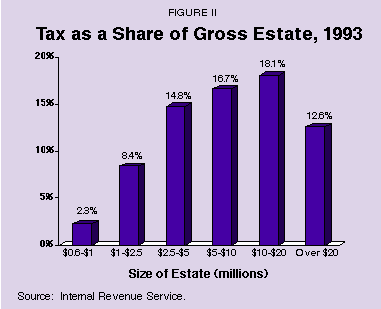
The rise in the number of taxable estates and estate tax revenue result mainly from the fixed level of the estate tax exemption, which has not been increased since 1986. In the time since, the Consumer Price Index has risen by almost 50 percent, raising the nominal value of many estates above the $600,000 threshold. Real economic growth and the aging of the population also serve to generate heightened interest in estate tax reform.
From all indications, the increase in the estate tax exemption will have a minimal impact on the growing effort to abolish the estate tax altogether. For one thing, the exemption increase is being phased in so slowly – about 6 percent per year – that its real value is not very large. In real terms, the $1 million exemption in 2006 will still be substantially less than $600,000 in 1986 dollars. Furthermore, a growing number of academic analyses question the value and efficacy of the estate tax. These studies help to embolden supporters of outright repeal.
"Sophisticated estate planning has made payment of the estate tax essentially voluntary."
The main argument supporting abolition of the estate tax is fairness. Although this tax falls exclusively on the rich (insofar as "rich" can be defined as having $600,000 in assets at death), sophisticated estate planning has made payment of the estate tax essentially voluntary.23
- Those who plan ahead and take full advantage of legal tax avoidance techniques can reduce their estate tax liability to zero if they choose.24
- Those who fail to plan may see their estates taxed up to 60 percent.25
- In the view of economists Henry Aaron and Alicia Munnell, estate taxes are not taxes at all, but "penalties imposed on those who neglect to plan ahead or who retain unskilled estate planners."26
However, owners of small to medium-size businesses evidently are less willing or able to avoid the tax. Thus taxes as a share of gross estates tend to be higher for estates between $2.5 million and $20 million than for larger ones [see Figure II].
"Taxes tend to be higher for estates between $2.5 million and $20 million than for larger ones."
Consequently, the estate tax is an extremely weak redistributor of wealth. This has been true for some time. As economist Alan Blinder of Princeton has observed, "estate taxation is not a very powerful weapon in the egalitarian arsenal."27 Economist Joseph Stiglitz of Stanford has even suggested that the estate tax may actually increase inequality.28
Economist Douglas Holtz-Eakin of Syracuse argues that the overall efficiency cost of the estate tax is small.29 However, in another article with economists Harvey Rosen and David Joulfaian, he previously had found the tax to be a significant burden on entrepreneurs.30 Economist B. Douglas Bernheim of Stanford has argued that common estate planning techniques reduce income tax revenues by more than the estate tax raises.31 In other words, the government raises no net revenue from the estate tax. Another analyst has speculated that the federal government might raise more revenue from taxing the incomes of estate planners than from the estate tax itself.32
"The government raises no net revenue from the estate rax."
Other analysts point to the heavy administrative burden of the estate tax, as well as the political impossibility of strengthening it to improve its revenue yield and redistributive purpose. They argue that the relatively small amount of revenue raised by the estate tax could more easily be raised by other means.33
[page]Whereas the child credit and capital gains and estate tax relief were major priorities of the Republican Congress, the Clinton administration was keen to initiate new tax incentives for education. The principal education provision that passed was the Hope scholarship program, which provides a tax credit up to $1,000 for the first year of tuition at a postsecondary institution and $500 for the second year. The credit is not refundable and is phased out for families with AGIs above $80,000. It will reduce federal revenues by $76 billion over the period 1997-2007, according to the JCT.
Although politically popular, new tax subsidies for higher education have been heavily criticized by economists. Economist Robert Moore argues that current tax treatment of education expenses already approximates the tax treatment of physical capital. He views additional tax incentives for education as tilting the tax code in favor of human capital and against physical capital.34
Other economists emphasize that the tax credit targets the wrong people. Since it is not refundable, it is not available to the poor who most need education subsidies. Its main effect will be to cut the taxes of families who would have sent their children to college anyway.35 Thus the credit is unlikely to increase aggregate human capital in the economy by very much. Economist Julie-Anne Cronin estimates an increase in enrollment of just 150,000 students per year.36
Furthermore, the education credit may engender tuition inflation, especially among two-year colleges. In 1994-95 fully one-third of such colleges charged students less than $1,000 to attend.37 Raising tuition to the $1,000 credit level will cost them virtually nothing. But they may need to expand facilities if demand increases.
"The most needy don't qualify for the new education credit, and those who qualify are not needy."
In summary, the new education credit does little to increase the availability of higher education. The most needy do not qualify, and those who qualify are not needy. The benefits may be entirely negated if tuition levels rise in response to the credit.
[page]The tax bill also created a new type of individual retirement account, the Roth IRA, named for the Senate Finance Committee chairman, who promoted the idea. The Roth IRA differs from a conventional IRA in that contributions are made with aftertax dollars but distributions, including earnings, are tax-free.
"The Roth IRA allows aftertax contributions and tax-free withdrawals."
Contributions are limited to $2,000 yearly, but eligibility to contribute is phased out for single taxpayers with adjusted gross incomes between $95,000 and $110,000 and for joint filers with adjusted gross incomes between $150,000 and $160,000. The law also allows a holder of a conventional IRA to pay taxes on it and convert it to a Roth IRA.
Both a taxpayer and spouse can contribute to Roth IRAs if their income is at least equal to the contributions. People can contribute to Roth IRAs even if they participate in a pension plan or contribute to conventional IRAs.
Proponents of Roth IRAs have long contended that the additional economic growth stimulated by funds from Roth IRA investments will generate new tax revenue that will more than offset any loss in taxes from making withdrawals tax-free.38
[page]The primary revenue increase in the tax bill was an extension of the airline ticket tax, with several modifications. The rate was reduced from 10 percent to 9 percent and will decline to 7.5 percent in 1999. To offset the revenue loss, the bill imposes a new tax of $1 on each domestic flight segment, rising to $3 in 2002. The international departure tax was raised from $6 to $12 per passenger and made applicable to arrivals as well. The effect of the changes is to make the airline tax somewhat more regressive. Passengers flying first class or paying full fares will pay less, while passengers flying coach or on discount tickets will pay more. Heavy lobbying by the nation's seven largest airlines in an effort to improve their competitive position vis-à-vis the growing number of discount airlines apparently brought about the change.39
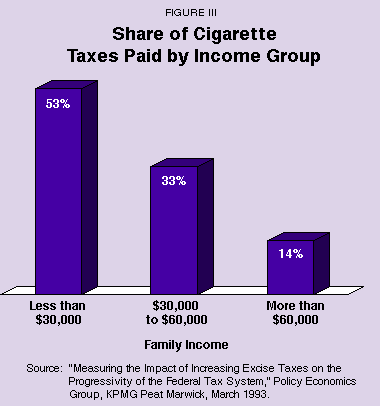
"First class and full fare passengers will pay less, while coach and discount passengers will pay more."
The other major revenue raiser was an increase in the cigarette tax from 24 cents per pack to 39 cents. Though not originally part of the budget agreement, the provision was added following announcement of the tobacco industry's decision to settle myriad lawsuits by paying $368 billion. The settlement greatly eroded the tobacco industry's ability to forestall cigarette tax increases through lobbying and political contributions. With smoking and the tobacco industry under political assault, a cigarette tax increase was simply an expedient way to raise revenue and offset tax cuts.
It is ironic, given the heated debate over the distribution of the tax package's benefits to people at various income levels, that the highly regressive increase in the cigarette tax passed almost without debate. A study by KPMG Peat Marwick found that families making less than $30,000 per year pay more than half of all cigarette taxes – a tax burden almost five times more as a percentage of income than that on families earning over $60,000 [see Figure III]. According to a more recent Tax Foundation analysis, those with AGIs under $15,000 will pay 34 percent of the tax increase and those with incomes under $30,000 will pay 60 percent.40 This is consistent with research showing that the incidence of smoking rises as incomes fall.41
The ease with which Congress was able to increase the cigarette tax by more than 60 percent, almost as an afterthought, suggests that larger increases will come. There are a number of proposals to increase cigarette taxes to recoup the costs smokers impose on society, such as increased expenditures to treat smoking-related diseases. But the truth is that smokers already pay their own way. After adjusting for inflation, the direct cost of smoking – 21 cents per pack in 1995 dollars – falls well below the 1995 average total of 63 cents per pack in federal and state taxes. Since smokers overpay their incremental costs, an additional tax is unfair.42
Higher cigarette taxes are strongly promoted on health grounds, but the morality of using large increases in "sin taxes" to punish legal but socially opprobrious behavior is questionable.43
[page]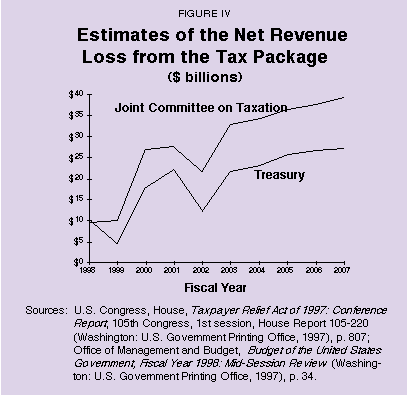
From the beginning, Congress and the Clinton administration disagreed on the distributional effects of the tax bill. Treasury Secretary Robert Rubin led the administration's effort to tilt the benefits of the tax cut toward those with lower incomes and away from the wealthy. In a June 11, 1997, letter to Ways and Means Committee Chairman Bill Archer, Rubin asserted that 67.9 percent of the benefits from cuts in the House version of the tax bill would go to the highest-earning 20 percent of families. In a letter to Finance Committee Chairman Bill Roth on June 18, Rubin estimated that 65.5 percent of the Senate tax bill would go to the highest-earning 20 percent.
Congress responded with analyses from the JCT showing a somewhat more balanced distribution of benefits. For example, a June 17 analysis of the Senate Finance Committee bill estimated that only 43.3 percent of the tax benefits would go to the top income group.44
"Families making less than $30,000 per year pay more than half of all cigarette taxes."
But the debate over how much of the tax cut would go to the wealthy versus the poor was really about apples versus oranges, the result of methodological differences between the Treasury and JCT going back many years. [See the Sidebar on Calculating Distributional Effects.] Because Congress and the administration were under the political control of opposing parties, it was often implied (incorrectly) that the conflicting analyses simply represented different political biases.
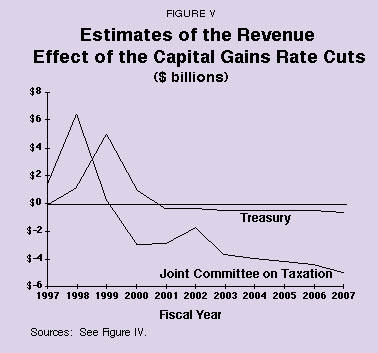
Figure IV shows how the two agencies scored the impact on federal revenues from the Taxpayer Relief Act. The JCT forecast a substantially larger revenue loss from the legislation than did the Treasury. The difference between the two estimates derived largely from the different estimates by Treasury and the JCT of the effects of the capital gains provision. Figure V indicates how the JCT and Treasury scored the revenue effect of the final capital gains provision. There was a difference of almost $25 billion between the two estimates for the period 1997-2007. [Also see Appendix Tables I and II.]
These sharply contrasting revenue estimates had important effects on the distributional analyses. The reason is that both Treasury and the JCT calculate distribution on a static basis. In other words, they assume that assets that are sold solely due to the lower capital gains rate would have been sold even in the absence of any tax change. Thus the larger the unlocking effect of cutting the capital gains tax, the bigger the tax cut for those with capital gains as reflected in the distributional tables. Because Treasury estimates a much larger unlocking effect than the JCT, it allocates a much larger tax cut to the wealthy in its distributional tables than does the JCT.
"Both Treasury and the JCT assume that assets that are sold solely due to the lower capital gains rate would have been sold even without a tax change."
As Figure VI and Appendix Tables III and IV indicate, a result of these methodological differences is that the estimated revenue loss from the Taxpayer Relief Act is 50 percent higher in Treasury's distribution table than in the JCT's. Indeed, Treasury's estimate of the tax cut distribution by income group is almost twice as much as the projected revenue reduction in its own revenue estimate, shown in Figure IV. By contrast, the distributed tax cut in the JCT's table is much closer to its estimate of the revenue loss.
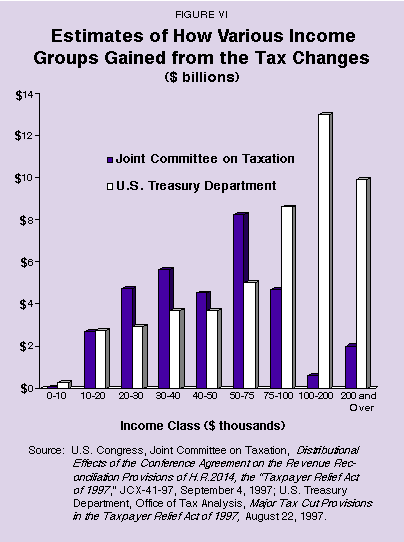
While there is no evidence that the Treasury or the JCT manipulate their distribution tables for political purposes, the ultimate result of their different methodologies was to bolster the political agendas of their respective masters. The JCT's methodology showed a smaller tax cut for the rich, thereby aiding the goals of the Republican Congress. Treasury's analysis supported the view of the Clinton administration that the tax cut was tilted toward the rich, even though Treasury's own revenue estimate scored the capital gains provision as a net revenue raiser over the entire forecast period.
"The JCT forecast a substantially larger revenue loss than did the Treasury."
In recent years, academic researchers have begun to pay greater attention to the problems inherent in calculating the distributional effects of tax changes over different income levels.45 Debate over the 1997 tax bill clearly shows that more work needs to be done.
[page]The Taxpayer Relief Act of 1997 is important more as a political statement than for its economic impact. As the first major tax cut since 1981, it marks the end of the paralysis in fiscal policy that resulted from the rise of large and persistent budget deficits in the 1980s. The legislation did not seek to make major changes in tax policy and did not do so. Its economic impact is likely to be minimal.
NOTE: Nothing written here should be construed as necessarily reflecting the views of the National Center for Policy Analysis or as an attempt to aid or hinder the passage of any bill before Congress.
[page]-
The agreement further limited the revenue loss in fiscal years 2003 through 2007 to $165 billion, in order to forestall back-loaded tax cuts.
- June E. O'Neill, letter to the Honorable Pete V. Domenici, May 2, 1997.
- For details and criticism of CBO's revenue revision, see Martin A. Sullivan, "CBO's Poor Judgment, Soft Numbers Raise Questions on Budget Process," Tax Notes, vol. 75, no. 7 (May 19, 1997), pp. 883-87.
- Public Law 105-34.
- Thomas M. Humbert, "Ending the Tax Code's Anti-Family Bias by Increasing the Personal Exemption to $6,300," Backgrounder No. 687, Heritage Foundation, 1989.
- U.S. Congress, House, Committee on Ways and Means, Contract with America Tax Relief Act of 1995, 104th Congress, 1st session, House Report 104-84 (Washington: U.S. Government Printing Office, 1995), pp. 10-11.
- This commission was also known as the Rockefeller Commission, after its chairman, Senator John D. Rockefeller IV (D-W.Va.).
- C. Eugene Steuerle and Jason Juffras, "Correcting Distortions in the Tax-Transfer System for Families with Children," Policy Bites No. 6 (Washington: Urban Institute, 1991).
- Robert Rector and Stuart M. Butler, "Reducing the Tax Burden on the Embattled American Family," Backgrounder No. 845, Heritage Foundation, 1991.
- See, for example, the testimony of Gary Bauer, president of the Family Research Council, and Marshall Wittmann, director of legislative affairs for the Christian Coalition in U.S. Congress, Joint Economic Committee, The Family First Act: The Economic Effects of a $500 Per-Child Expanded Tax Credit (Washington: U.S. Government Printing Office, 1996).
- The Tax Reform Act of 1986 raised the top rate on capital gains from 20 percent to 28 percent in order to equalize the tax treatment of capital gains and ordinary income. Interestingly, in 1993 when President Clinton and a Democratically controlled Congress raised the top rate on ordinary income from 28 percent to 39.6 percent, they left the top rate on capital gains at 28 percent. Thus the Clinton administration had proven itself willing to accept a lower tax rate on capital gains even before debate on the 1997 legislation began.
- The taxpayer would face a capital gains tax on this fictitious transaction, but if the asset were sold in the future, further gains would be taxed at the lower rate.
- James R. Repetti, "The Use of Tax Law to Stabilize the Stock Market: The Efficacy of Holding Period Requirements," Virginia Tax Review, vol. 8, no. 3 (Winter 1989), pp. 591-637. The vast bulk of trading in the stock market today is not by individuals who are affected by the holding-period requirement but by institutions mainly trading on behalf of tax-exempt pension funds.
- Robert B. Reich, The Resurgent Liberal (New York: Times Books, 1989), pp. 21-22.
- Steven Kaplan, "The Holding-Period Distinction of the Capital Gains Tax," NBER Working Paper No. 762 (Cambridge, Mass.: National Bureau of Economic Research, 1981).
- Repetti, op. cit.
- For a discussion of this point, see Harold M. Somers, "Capital Gains Tax: Significance of Changes in Holding Period and Long-Term Rate," Vanderbilt Law Review, vol. 16, no. 3 (June 1963), pp. 509-33.
- The revenue loss from cutting the capital gains tax falls from -$2,934 million in FY2001 to -$1,785 million in FY2002, rising again to -$3,742 million in 2003. U.S. Congress, House, Taxpayer Relief Act of 1997: Conference Report, 105th Congress, 1st session, House Report 105-220 (Washington: U.S. Government Printing Office, 1997), p. 780.
- Lee A. Sheppard, "Should Sales of Personal Residences Be Exempt from Tax?" Tax Notes, vol. 50, no. 12 (March 25, 1991), pp. 1433-34.
- There is, of course, considerable debate on the economic effects of capital gains taxes. For a recent review of the evidence, see George R. Zodrow, "Economic Analysis of Capital Gains Taxation: Realizations, Revenues, Efficiency and Equity," Tax Law Review, vol. 48, no. 3 (Spring 1993), pp. 419-527.
- Richard W. Stevenson, "The Long Arm of Small Business," New York Times, June 12, 1997.
- U.S. Congress, Joint Committee on Taxation, Description and Analysis of Proposals Relating to Estate and Gift Taxation, JCS-7-97 (Washington: U.S. Government Printing Office, 1997), pp. 23, 31.
- George Cooper, A Voluntary Tax? New Perspectives on Sophisticated Estate Tax Avoidance (Washington: Brookings Institution, 1979). See also Christopher Drew and David Cay Johnston, "For Wealthy Americans, Death Is More Certain than Taxes," New York Times, December 22, 1996.
- For a recent review of estate planning techniques, see John A. Miller and Jeffrey A. Maine, "Fundamentals of Estate Planning," Idaho Law Review, vol. 32, no. 2, pp. 197-252.
- The top statutory estate tax rate is 55 percent, but the effective rate is 60 percent for estates between $10 million and $21 million, due to phase-out of the graduated rates and the estate tax exemption.
- Henry J. Aaron and Alicia H. Munnell, "Reassessing the Role for Wealth Transfer Taxes," National Tax Journal, vol. 45, no. 2 (June 1992), pp. 119-43.
- Alan S. Blinder, "Inequality and Mobility in the Distribution of Wealth," Kyklos, vol. 29, no. 4 (1976), pp. 607-38.
- Joseph E. Stiglitz, "Notes on Estate Taxes, Redistribution, and the Concept of Balanced Growth Path Incidence," Journal of Political Economy, vol. 86, no. 2, pt. 2 (April 1978), pp. S137-50.
- Douglas Holtz-Eakin, "The Uneasy Empirical Case for Abolishing the Estate Tax," Tax Law Review, vol. 51, no. 3 (Spring 1996), pp. 495-515.
- Douglas Holtz-Eakin, David Joulfaian and Harvey Rosen, "Sticking It Out: Entrepreneurial Survival and Liquidity Constraints," Journal of Political Economy, vol. 102, no. 1 (February 1994), pp. 53-75.
- B. Douglas Bernheim, "Does the Estate Tax Raise Revenue?" in Lawrence H. Summers, ed., Tax Policy and the Economy 1 (Cambridge, Mass.: MIT Press, 1987), pp. 113-38.
- Gerald P. Moran, "Estate and Gift Taxation: The Case for Repeal," Tax Notes, vol. 13 (August 17, 1981), pp. 339-43.
- Edward J. McCaffrey, "The Uneasy Case for Wealth Transfer Taxation," Yale Law Journal, vol. 104, no. 2 (November 1994), pp. 283-365; Joel C. Dobris, "A Brief for the Abolition of All Transfer Taxes," Syracuse Law Review, vol. 35, no. 4 (1984), pp. 1215-34; Charles O. Galvin, "To Bury the Estate Tax, Not to Praise It," Tax Notes, vol. 52, no. 12 (September 16, 1991), pp. 1413-19; Christopher E. Erblich, "To Bury Federal Transfer Taxes without Further Adieu," Seton Hall Law Review, vol. 24, no. 4 (1994), pp. 1931-68; and Bruce Bartlett, "The End of the Estate Tax?" Tax Notes, vol. 76, no. 1 (July 7, 1997), pp. 105-10.
- Robert L. Moore, "Aspects of the Tax Treatment of Expenditures for Higher Education," Tax Notes, vol. 75, no. 4 (April 28, 1997), pp. 565-71.
- Thomas J. Kane, "Beyond Tax Relief: Long-Term Challenges in Financing Higher Education," National Tax Journal, vol. 50, no. 2 (June 1997), pp. 335-49; Michael S. McPherson and Morton Owen Schapiro, "Financing Undergraduate Education: Designing National Policies," National Tax Journal, vol. 50, no. 3 (September 1997), pp. 557-71.
- Julie-Anne Cronin, "The Economic Effects and Beneficiaries of the Administration's Proposed Higher Education Tax Subsidies," National Tax Journal, vol. 50, no. 3 (September 1997), pp. 519-40.
- Peter Passell, "A Break for Students," New York Times, July 15, 1997.
- See, for example, NCPA Policy Report No. 112, National Center for Policy Analysis, April 1991.
- Greg Hitt, "Airlines Taxi into Position around Capitol Hill as Lawmakers Make Decisions on Ticket Taxes," Wall Street Journal, July 9, 1997.
- Tax Foundation, Tax Features, vol. 41, no. 6 (June 1997), p. 1.
- Joy L. Townsend, "Cigarette Tax, Economic Welfare and Social Class Patterns of Smoking," Applied Economics, vol. 19, no. 3 (March 1987), pp. 355-65.
- Sue A. Blevins, "Will a Cigarette Tax Increase Really Help Uninsured Children?" Brief Analysis No. 231, National Center for Policy Analysis, May 23, 1997.
- Jendi B. Reiter, "Citizens or Sinners? The Economic and Political Inequity of 'Sin Taxes' on Tobacco and Alcohol Products," Columbia Journal of Law and Social Problems, vol. 29, no. 3 (Spring 1996), pp. 443-68.
- U.S. Congress, Joint Committee on Taxation, Distributional Effects of the Revenue Reconciliation Provisions Contained in the Senate Finance Committee Chairman's Mark, JCX-34-97, June 17, 1997.
- See Michael J. Graetz, "Paint-by-Numbers Tax Lawmaking," Columbia Law Review, vol. 95, no. 3 (April 1995), pp 609-82; Thomas A. Barthold, "How Should We Measure Distribution?" National Tax Journal, vol. 46, no. 3 (September 1993), pp. 291-99; R. Glenn Hubbard, "On the Use of 'Distribution Tables' in the Tax Policy Process," National Tax Journal, vol. 46, no. 4 (December 1993), pp. 527-37; Martin Feldstein, "Imputing Corporate Tax Liabilities to Individual Taxpayers," National Tax Journal, vol. 41, no. 1 (March 1988), pp. 37-59; John Sabelhaus, "What Is the Distributional Burden of Taxing Consumption?" National Tax Journal, vol. 46, no. 3 (September 1993), pp. 331-44; Don Fullerton and Diane Lim Rogers, Who Bears the Lifetime Tax Burden? (Washington: Brookings Institution, 1993); and Albert J. Davis, "Measuring the Distributional Effects of Tax Changes for the Congress," National Tax Journal, vol. 44, no. 3 (September 1991), pp. 257-68.
